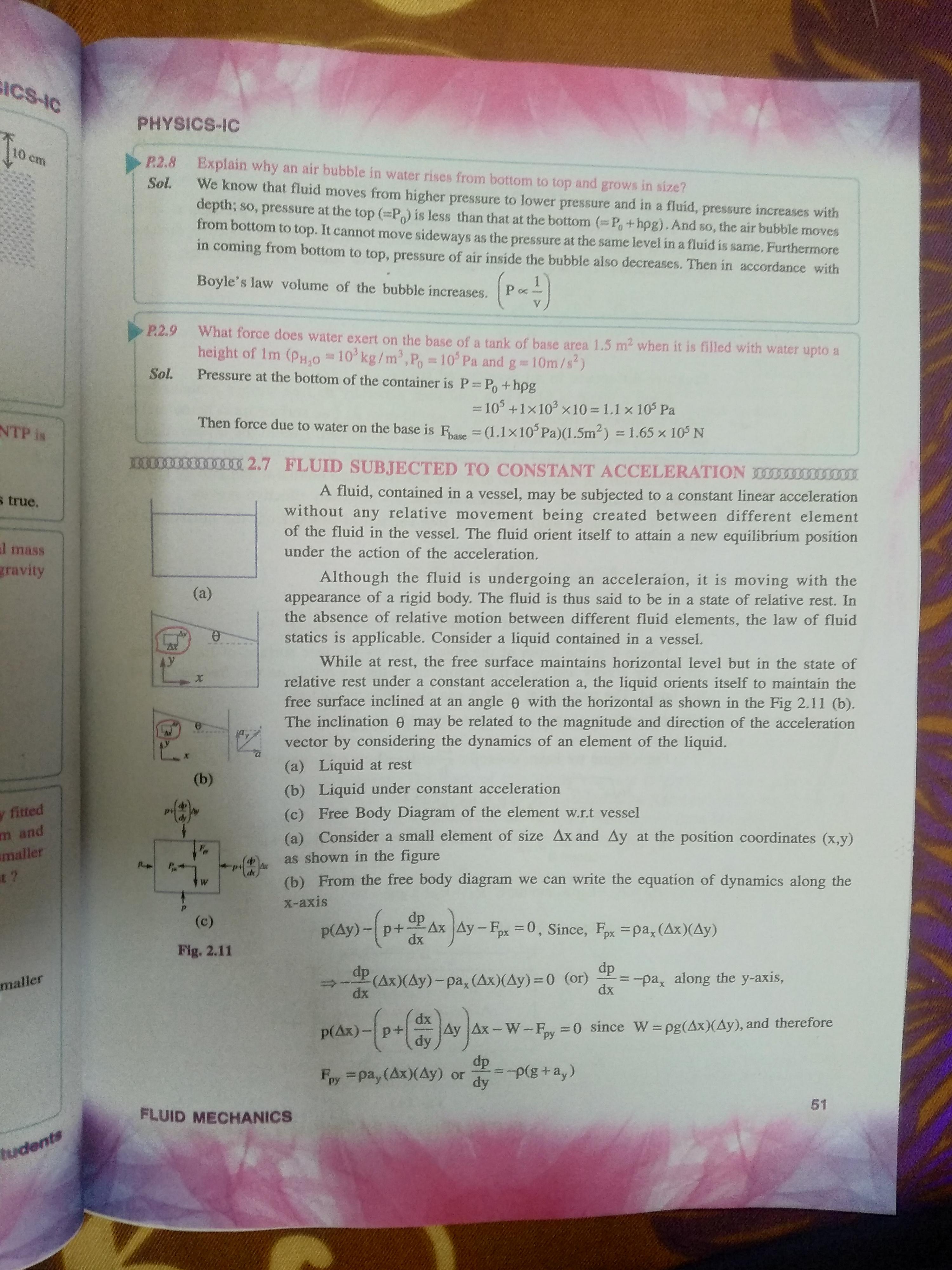Answered step by step
Verified Expert Solution
Question
1 Approved Answer
Create the keynotes of the given below text in your own words. GICS-IC PHYSICS-IC 10 cm P.2.8 Explain why an air bubble in water rises
Create the keynotes of the given below text in your own words. 
GICS-IC PHYSICS-IC 10 cm P.2.8 Explain why an air bubble in water rises from bottom to top and grows in size? We know that fluid moves from higher pressure to lower pressure and in a fluid, pressure increases with depth; so, pressure at the top (=P) is less than that at the bottom ( P,+hpg).And so, the air bubble moves from bottom to top. It cannot move sideways as the pressure at the same level in a fluid is same. Furthermore Sol. in coming from bottom to top, pressure of air inside the bubble also decreases. Then in accordance with Boyle's law volume of the bubble increases. V. P.2.9 What force does water exert on the base of a tank of base area 1.5 m2 when it is filled with water upto a height of 1m (pH,0 10 kg/m',P, 10 Pa and g 10m/s) Pressure at the bottom of the container is P Po+hpg %3D Sol. = 10 +1x103 x10 = 1.1 x 105 Pa Then force due to water on the base is Re = (1.110 Pa)(1.5m) = 1.65 10 N NTP is %3D DIIIIIIII 2.7 FLUID SUBJECTED TO CONSTANT ACCELERATION m m A fluid, contained in a vessel, may be subjected to a constant linear acceleration without any relative movement being created between different element of the fluid in the vessel. The fluid orient itself to attain a new equilibrium position s true. l mass under the action of the acceleration. gravity Although the fluid is undergoing an acceleraion, it is moving with the appearance of a rigid body. The fluid is thus said to be in a state of relative rest. In the absence of relative motion between different fluid elements, the law of fluid (a) statics is applicable. Consider a liquid contained in a vessel. While at rest, the free surface maintains horizontal level but in the state of relative rest under a constant acceleration a, the liquid orients itself to maintain the free surface inclined at an angle e with the horizontal as shown in the Fig 2.11 (b). The inclination 0 may be related to the magnitude and direction of the acceleration vector by considering the dynamics of an element of the liquid. AY (a) Liquid at rest (b) (b) Liquid under constant acceleration y fitted m and maller t ? (c) Free Body Diagram of the element w.r.t vessel (a) Consider a small element of size Ax and Ay at the position coordinates (x,y) as shown in the figure (b) From the free body diagram we can write the equation of dynamics along the W X-axis (c) p(Ay)-p+ dx dp Ax Ay-Fx =0, Since, Fx =pa, (Ax)(Ay) Fig. 2.11 (Ax)(Ay)-pa, (Ax)(Ay) = 0 (or) dx dp =-pa, along the y-axis, dx maller dx Ay Ax-W-Fy =0 since W = pg(Ax)(Ay), and therefore dy p(Ax)-p+ %3D dp =-p(g+ay) dy Fpy =pa, (Ax)(Ay) or %3D 51 FLUID MECHANICS tudents
Step by Step Solution
★★★★★
3.40 Rating (163 Votes )
There are 3 Steps involved in it
Step: 1
Key points are Unlike static liquid the horizontally accelerated liquid does not ha...
Get Instant Access to Expert-Tailored Solutions
See step-by-step solutions with expert insights and AI powered tools for academic success
Step: 2

Step: 3

Ace Your Homework with AI
Get the answers you need in no time with our AI-driven, step-by-step assistance
Get Started


